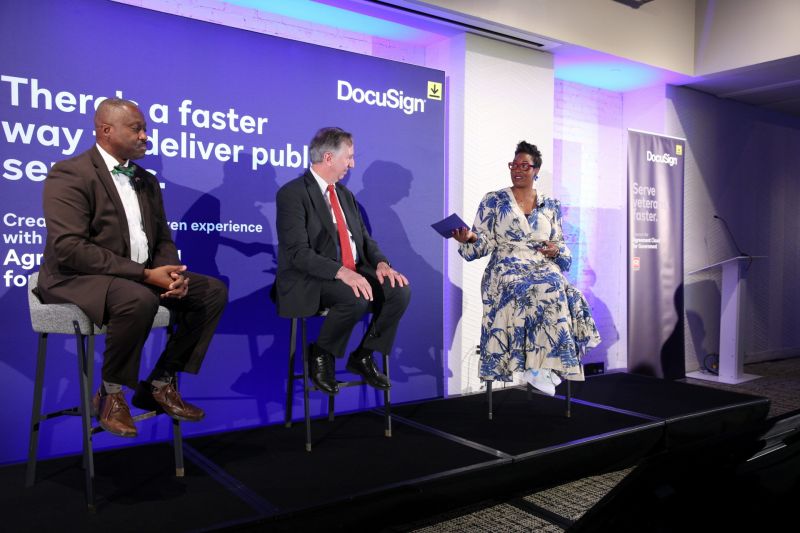

CIO Guy Cavallo and deputy CIO Melvin Brown are bringing the lessons they learned from the Small Business Administration to change OPM’s culture, modernize it...
If you want to see just how the Office of Personnel Management is recovering from the turmoil of the failed merger with the General Services Administration during the Trump administration, look no further than the Office of the Chief Information Officer.
Guy Cavallo, the CIO, Melvin Brown, the deputy CIO, and their team are taking the lessons they learned from their successful efforts at the Small Business Administration to change OPM’s culture, modernize its technology and address long-standing workforce issues.

“One thing I’ve learned as a leader is I have to lead,” Cavallo said during a recent event sponsored by DocuSign. “I don’t schedule that project meeting, do a five minute kickoff and then disappear. I’m there the whole time. I’m showing the culture that I’m paying attention. I’m very appreciative of every project that we’re working on, and I can help them.”
And it’s not just in the CIO or on IT projects that Cavallo and Brown are leading. It’s in working with the mission areas to solve problems and not accepting any whining about the roadblocks they are facing.
“One rule that I have, and this one took a while to do in culture, is to ask what are your blockers? Initially, everybody’s blockers were ‘I don’t have enough money and enough staff.’ And I said, ‘OK, how can I take that to the CFO? You need to tell me exactly, what do you need? Otherwise, it’s whining, because we all could use more money, we all could use more staff,’” he said. “It shifted that culture, to ‘Oh, Guy’s not going to let me just complain, he actually is going to ask me for what do I need to fix this?’ I’ve seen the team transition from whining to I need an enterprise architect for six months, or I need a network engineer or a cloud architect for eight months on this project. That gives me something to go back and work from.”
Cavallo brings a refreshing view and attitude to OPM. Previous CIOs, of which Cavallo is the 10th in the last decade, where mostly capable, but didn’t have the patience, desire or fortitude to drive the broader change that’s needed.
Cavallo and Brown learned the key ingredients that go into changing a culture from their time with Maria Roat at SBA.
“We have done what we said we will do and that is key,” Brown said. “Employees were concerned about the CIO being a revolving door over the years, but now that there is some stable leadership there, people are gravitating in and we are getting some support.”
To that end, the CIO’s office created a “champion’s network,” made up of CIO staff and business areas leaders from across the agency.
“Whenever we are rolling out new technologies, they are our first line people to give us feedback, to look at our rollout plans to talk about our communication strategy and to help us with the overall change management and adoption of the technology” Brown said. “Without the adoption of technology, you just built the house that nobody’s living in. We want to build a house that people want to live in and the community that the business wants to join.”
Brown added the CIO’s office always celebrates the successes what he jokingly termed as a “happy dance.”
“We reinforce the teams that are doing well. We do that on a monthly basis and people started to catch on,” he said at the same event. “The key to doing that is reinforcing the behavior that you want to see. We would do that on a monthly basis, and people started to catch on.”
The other big challenge OPM is facing is its workforce. Like many agencies, OPM has a dearth of younger employees. And unlike many agencies, its workforce is smaller than maybe ever before.
OPM’s workforce hasn’t fully recovered from the merger failure where hundreds of employees retired or found new jobs. The agency’s fiscal 2023 budget justification stated OPM has just over 3,000 employees and plan to add another 219 in the coming year. This is down from more than 5,500 workers in 2018. Some of that total worker decrease is attributed to the movement of the National Background Investigation Service (NBIS) to the Defense Department in 2019.
One way Cavallo and Brown are addressing that shortage of workers is through interns.
Cavallo said he expected Brown to hire four or five interns, but instead he brought in 18 last summer.
Browns said OPM received about 200 applicants for the positions that ranged from cyber to cloud to modernization. The interns were mostly remote with some living in the West and Midwestern part of the country.
“These first 18 were to establish our baseline or bench. I’m not sure how many we plan to have next summer, but it’s a program we hope will continue to do every year,” Brown said. “We had the need and the money for it so we were able to bring them in as GS-4 and GS-5s, so low cost for big talent. It really is a success story about how OPM is using the available hiring authorities to support modernization.”
Cavallo is hoping to hire some interns at GS-7 or GS-9 level.
“Our plan was I’ve taken those positions as they become vacant and we’ve downgraded them into a career ladder,” he said. “I urge you to look at your organization. If you’ve had grade creep, you’re going to end up with an older and older workforce, and then five years from now, they’re all going to be retired and you’re going to have empty chairs. You’ve got to make those changes today.”
To be clear, OPM has a long way to go. Many of the agency’s systems and processes remain stuck in the past.
The frustration around the time it takes for OPM to process retirement claims of an average of 87 days is one shining example of the major modernization challenges that still need to be addressed. And there are dozens of others. Brown said only about 10% of all workloads or applications are in the cloud, and the need for business process reengineering is just as great as the need to move to modern technology.
But in the short two years Cavallo has been the CIO, it’s clear his team is using the power of technology to build bridges across the agency to improve mission services and the way customers, internal and external, view OPM.
“We both love technology, but what you’re hearing us talk about is people, people, people. When I got to OPM, the relationship with the CIO’s union was in a very bad place. We set up a monthly meeting, scheduled that both Melvin and I attend, we make sure we don’t skip that meeting. We make sure we’re that we’re available,” Cavallo said. “It was interesting to see the first few meetings while everybody was on Teams, Melvin and I were on camera, but nobody else was. We just kept coming back with us being on camera, you’re going to see us and all of a sudden one, turned the camera on, and now everyone has their cameras on. It’s the investment and time we are putting in. There’s a lot of things that we could do with an hour of our time, but without making this investment in our employees and in our union relationship is important because it’s the people that can kill technology progress. Technology, by itself, will not win without having your workforce behind it.”
Much of the garbage seen on-screen in the movie “Taxi Driver” is real trash left on the streets of New York. The summer they filmed it, there was a sanitation workers’ strike in the city.
Source: Mental Floss
Copyright © 2024 Federal News Network. All rights reserved. This website is not intended for users located within the European Economic Area.
Jason Miller is executive editor of Federal News Network and directs news coverage on the people, policy and programs of the federal government.
Follow @jmillerWFED

